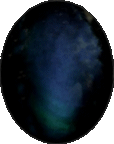| |
Obsidian
|
Obsidian is named after Opsius, the Roman explorer credited by Pliny with the discovery of the material in Ethiopia. Obsidian is a natural glass that is formed when lava cools quickly. Though usually black, several colors exist, the more popular varieties being the deep speckled mahogany obsidian and the resplendent rainbow obsidian.
Though Pliny claimed the material was used extensively in signet rings, few examples have survived. This could be because of preservation bias. There is the possibility that Pliny misidentified some paste gems as obsidian. These faux gems were made from cut glass, and signets of this material are more common in the archeological record than obsidian during Pliny’s time. Pliny wrote an extensive section on trying to discern the difference between the two materials, suggesting that during his time there was indeed some confusion.
Several centuries later the Gnostics began making pendants with the mysterious Abraxas engraved in obsidian. A great many of these “Abraxas stones” have survived to this day. Though their purpose is unknown; Pliny recorded accounts of black obsidian protecting the wearer from witchcraft. His writings were known by the Gnostics, and culturally incorporated into many of their practices, however there is no way to say for certain that this was the basis or purpose of the practice.
The stone saw much more use in pre-Columbian America, where obsidian was prized for its use in weapons and ceremonial tools. Metallurgy did not develop in the Americas prior to the arrival of Colombus past decorative gold and copper work. So many of the indigenous nations continued to develop their knowledge with lithic technology to a degree that had not been seen in the old world for many centuries. One of the most famous of these weapons is the Macuahuitl, an obsidian club used by the Aztecs. This was an interesting piece of technology because it allowed for broken bladelets to be replaced in the club.
The Mayans elites used obsidian laced cords to cut their tongues and obsidian triangles to cut their penises during bloodletting rituals. There also seems to be some historical accounts of large obsidian statues or totems in central America, though today only smaller idols have survived. Because of the abundance of obsidian in central and south America, it has become a common material for souvenir statues. This makes it appear to modern tourists that obsidian statuary was much more commonplace than it was historically.
But perhaps the most famous folkloric use of obsidian was in divination. Many European myths talk of black “seeing stones”, these stones allowed individuals to foretell the future or see things happening in other places. Though most of the folktales did not specify what material the stone was made from, we do have a surviving example from Queen Elizabeth’s court sorcerer and astrologer John Dee. This scrying stone has interestingly enough been confirmed to be obsidian form central America, and a few researchers have suggested that it resembles obsidian mirrors found in pre-Columbian Peru.
The manufacture of scrying mirrors was more specific in European ceremonial magic. These mirrors were created by slicing the stone into slabs, polishing them, and then backing them with silver. In cheaper versions the silver would be replaced with tinning or other reflective substances. These types of mirrors often came with special rules such as not using them at specific times or exposing them to daylight.
|
Colors
|
various
|
Locations
|
Anywhere with past volcanic activity.
|
Compisition
|
SiO2, with impurities
|
Hardness
|
6
|
|

|

|

|
|
|
|
|
|